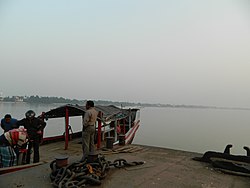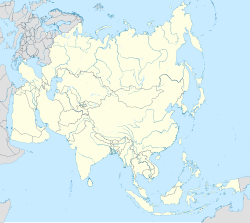Konnagar
This article has multiple issues. Please help improve it or discuss these issues on the talk page. (Learn how and when to remove these messages)
|
Konnagar | |
|---|---|
Town | |
 Konnagar Ferry Ghat which connects Konnagar to Sodepur | |
| Coordinates: 22°42′12″N 88°19′07″E / 22.7032°N 88.3185°E | |
| Country | |
| State | West Bengal |
| District | Hooghly |
| Region | Greater Kolkata |
| Government | |
| • Type | Municipality |
| • Body | Konnagar Municipality |
| Area | |
• Total | 4.67 km2 (1.80 sq mi) |
| Elevation | 14 m (46 ft) |
| Population (2011) | |
• Total | 76,172 |
| • Density | 16,000/km2 (42,000/sq mi) |
| Languages | |
| • Official | Bengali[1][2] |
| • Additional official | English[2] |
| Time zone | UTC+5:30 (IST) |
| PIN | 712235 |
| Telephone code | +91 33 |
| Vehicle registration | WB |
| Lok Sabha constituency | Sreerampur |
| Vidhan Sabha constituency | Uttarpara |
| Website | www |
Konnagar is a town and a municipality of Hooghly district in the state of West Bengal in India. It is under Uttarpara police station in Serampore subdivision.[3] It is a part of the area covered by Kolkata Metropolitan Development Authority (KMDA).[4]
History
In 1931, Tomas Bata, the Czech shoe tycoon, established his first Indian operation at Konnagar. By 1936, the Konnagar plan was phased out. In May 1931, Tomas sold his business interests to his brother Jan Antonin Bata who established Batanagar, Bata's first permanent shoe factory in India. The Bata brand was established on 24 August 1894 in Zlín, Czech Republic. The company first established itself in India in 1931 by renting a building to start an experimental shoe production plant in Konnagar, West Bengal with 75 Czech experts. Though it was under Jan Antonin Bata administration that designed, developed and built the industrial city called Batanagar in 1934. Jan Bata also build factories in Digha near Patna, and elsewhere in India, employing more than 7,000 people. Batanagar, under Jan Bata's ideals became one of the bigger sub-urban towns near Kolkata.
Konnagar has been the home of many notable personalities. It was the ancestral home of the great nationalist and religious leader Sri Aurobindo[5] and noted physicist Sisir Kumar Mitra.[6] Shafiur Rahman one of the martyrs of the language movement in East Pakistan was born in Konnagar.[7]

The town had been visited by the greats of Tagore, Mahasweta Devi and many others. Tagore was believed to be just a child when he and his family came to this town to escape the onslaught of Dengue which hit Kolkata. He revisited the town again when he was 19. He came to visit the Brahmasomaj Ghat along with his father Maharshi Debendranath. Shibram Chakraborty used to live here for a brief period of time in his childhood near G.T.Road beside Konnagar High School.Sri Aurobindo's father and famous Indian geographer Shashi Bhusan Chatterjee happened to be a pupil of Konnagar High School established in the 19th century. And the town though got recognition chiefly due to the initiatives of Sib Chandra Deb, its antiquity can hardly be denied. Its reference is there even in the 500-year-old Mangal-Kāvya.
Konnagar is well known for its Shakuntala Kali Temple. This temple is considered to be very sacred and people from various parts of West Bengal pay a visit. This is a Puja that was started by the Chakraborty Bari Zamindars and today it has become an important event in Konnagar's calendar. The annual Puja is held in the Bengali calendar month of Boisakh (April). A very interesting fact about this Puja is that the idol is completed on the day of Puja itself.[citation needed] There are grand Fairs organised on the grounds adjacent to the temple.

Apart from this Puja, there is another important puja in this small city. Rajrajeshwari Puja has been organised in Konnagar for over 300 years now. It is held on the eve of Maghi Purnima (February).
Geography
Konnagar is located at 22°42′12″N 88°19′07″E / 22.7032°N 88.3185°E.[8] It has an average elevation of 14 metres (45 feet). Konnagar is positioned between Rishra and Hind Motor on the Howrah-Bardhaman main line and Grand Trunk Road. It is located on the west bank of the River Hooghly. Its approximate area is 4.32 km2.

West side of the Konnagar railway station is called Nabagram and Kanaipur. Most of the population in Nabagram is migrated from East Bengal. Being situated only 13.5 km from the heart of Kolkata, the area enjoys semi urban status. Konnagar has an extensive fruit and vegetable market which is visited by people from the nearby areas. The market is famous for its affordable prices.[citation needed] Konnagar is filled with many cultural clubs which makes it a culturally rich town.[citation needed]
Konnagar is also known for its famous Shakuntala Kalitala Mandir, Baro Mandir, Rajrajeswari Mandir, Shankaracharya Temple, Bungalow of Abanindranath Tagore, Paternal house of Rishi Aurobindo Ghosh, Bramhosomaj Ghat and house made by Raja Rammohan Roy. The first ever workshop of Bata Shoe Company Ltd. in India was initially set up in Konnagar in 1932. Baro Mandir (Dwadosh Mandir Ghat/Twelve Temples) was built in 1821 in the bank of Ganges river. The Bungalow of Abanindranath Tagore is a heritage place of the city.
Demographics
As per 2011 Census of India Konnagar had a total population of 76,172 of which 38,653 (51%) were males and 37,519 (49%) were females. Population below 6 years was 5,815. The total number of literates in Konnagar was 63,911 (90.84% of the population over 6 years).[9]
The following Municipalities and Census Towns in Hooghly district were part of Kolkata Urban Agglomeration in 2011 census: Bansberia (M), Hugli-Chinsurah (M), Bara Khejuria (Out Growth), Shankhanagar (CT), Amodghata (CT), Chak Bansberia (CT), Naldanga (CT), Kodalia (CT), Kulihanda (CT), Simla (CT), Dharmapur (CT), Bhadreswar (M), Champdani (M), Chandannagar (M Corp.), Baidyabati (M), Serampore (M), Rishra (M), Rishra (CT), Bamunari (CT), Dakshin Rajyadharpur (CT), Nabagram Colony (CT), Konnagar (M), Uttarpara Kotrung (M), Raghunathpur (PS-Dankuni) (CT), Kanaipur (CT) and Keota (CT).[10]
Education
Nabagram Hiralal Paul College, a general degree college, was established in 1957, at Nabagram, Konnagar. Prof. Sudhangshu Sekhar Bhattacharya, from the Bhattacharya family of Nabagram was one of the early member of this college and a big contributor to the build-up of the college.[11] Every year there is a alumni meet on first Sun day of the year. There are other two high schools in Konnagar named as Konnagar Hindu Girls' High School and Konnagar Boys' High School.
Culture
To accommodate the cultural events in Konnagar, the Municipality erected an auditorium "Rabindra Bhawan". This auditorium was built under supervision of the then Chairman of Konnagar Municipality, Samir Bandyopadhyay and his group of advisers such as Bireswar Bandyopadhay, Bishnupada Dutta and other renowned cultural personalities from Konnagar. Rabindra Bhavan is now rented for conducting school programs, other cultural activities. Recently a bust of Shibchandra Deb, the founder of modern Konnagar, has been unveiled.[citation needed]
A Book fair and Industrial Fair is also held every year by the Municipality at the Shakuntala Field in January/February.[citation needed]
In Nabagram Vidyaprrth play ground every year book fair is organized in the month of January, and a food festival is also organized in Jagritri Sangha Math for 3 days in January every year.
Transport

Konnagar is well connected with Howrah through trains. Konnagar lies on the Howrah-Bardhaman main line. Konnagar railway station has three platforms (1 for Down train, 2 for both and 3 for Up trains). Konnagar is also connected to Kolkata through roadways by State Highway 6/ Grand Trunk Road.
Private bus
- 2 Chunchura Court - Dakshineswar
- 285 Serampore - Salt Lake Sector-5
- 3 Serampore- Bagbazar/Salt Lake
- D4/1 Serampore- Bagbazar( up to Belgachia)
There are regular auto services available also towards Bally. Apart from this, there are Ferry Services to Greater Kolkata (Panihati) on the other end of Ganges banks. Now ferry service becomes more frequent. Netaji Subhas Chandra Bose International Airport is 17 km from Konnagar.
Notable people
- Aurobindo Ghosh (Rishi), a famous freedom fighter.
- Premendra Mitra a renowned Bengali writer.
- Shafiur Rahman, martyr of the 1952 Language Movement.
- Digambar Mitra, famous Kolkata-based descendant of Mitra family of Konnagar.
- Sisir Kumar Ghosh, Social reformer.
- Sisir Kumar Mitra, Scientist and pioneer of radio-science in India.
References
- ^ "52nd Report of the Commissioner for Linguistic Minorities in India" (PDF). Nclm.nic.in. Ministry of Minority Affairs. p. 85. Archived from the original (PDF) on 25 May 2017. Retrieved 29 August 2019.
- ^ a b "Fact and Figures". Wb.gov.in. Retrieved 29 August 2019.
- ^ District-wise list of statutory towns Archived 27 September 2007 at the Wayback Machine
- ^ "Base Map of Kolkata Metropolitan area". Kolkata Metropolitan Development Authority. Archived from the original on 28 September 2007. Retrieved 3 September 2007.
- ^ "Sri Aurobindo". www.meta-religion.com.
- ^ "Sisir Kumar Mitra". 5 March 2007. Archived from the original on 5 March 2007.
- ^ http://www.mukto-mona.com/new_site/mukto-mona/bengali_heritage/bangla_language_movement.htm [dead link]
- ^ "Census of India 2011, West Bengal: District Census Handbook, Hooghly" (PDF). Map of Serampur-Uttarpara CD Block, page 635. Directorate of Census Operations, West Bengal. Retrieved 26 September 2018.
- ^ "2011 Census – Primary Census Abstract Data Tables". West Bengal – District-wise. Registrar General and Census Commissioner, India. Retrieved 15 June 2016.
- ^ "Provisional Population Totals, Census of India 2011" (PDF). Constituents of Urban Agglomeration Having Population Above 1 Lakh. Census of India 2011. Retrieved 16 June 2016.
- ^ "Nabagram Hiralal Paul College". NHPC. Retrieved 30 June 2017.



